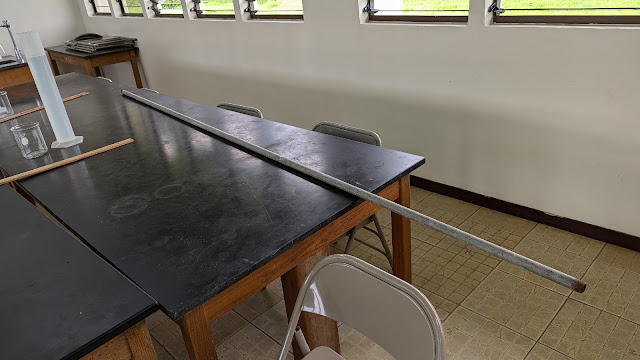Sound speed with resonance tubes
Invest 90w brought heavy rain along with thunder and lightning to the morning skies. I opted to run the inside version of the sound speed lab using graduated cylinders as resonance tubes.
Prior runs of the resonance tubes laboratory found that using a second graduated cylinder to pour the water resulted in spurious resonances. Erlenmeyer flasks were too narrow for the pouring back and forth procedure now used to offset large errors in the first run of the lab. This time I remembered to bring the meter sticks. Early set up ensured that there was enough water to in the tubes to run the lab.
1000 ml beakers worked well today, but many groups needed two 1000 ml beakers to handle the water. 256 Hz has a roughly 32 cm quarter wavelength. In these tubes that requires pouring off more than 1000 ml of water.
Springs were used with limited success to demonstrate standing waves.
A steel pipe was used to demonstrate that tones are quantized in a pipe. Only harmonics based on the pipe length are reinforced.
Notes at the start of the laboratory plus 8:00 data. The students trickled in one by one starting at 8:00. The first group to form was already recording data to the board, the subsequent groups added their data. This worked better than individual groups calculating their own speed of sound.
Board after 11:00
Charla and Gabby
Sheral recording data to the board
Sheral teaching Sucie how the lab is done as Kapualani looks on. Kapualani was the first to arrive and had explained the laboratory to Sheral. Sucie would later explain to Emylia.
Louisa joins the most recently formed group.
The resonance cannot be heard in the video. The microphone just doesn't pick it up.
8:00 results. Velocity is in centimeters per second.
Che'chemely works with Sonya in the 11:00 section.
Darla and Morgianna
Margrett
Nakisha and Sinae
Dantez and Jemara
Angelica and Joann
Shawn Dee, Delailah, and Margrett
11:00 data
11:00 analysis


























Comments
Post a Comment